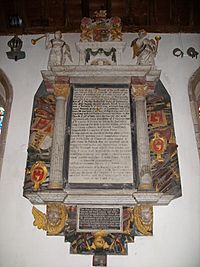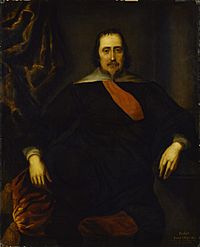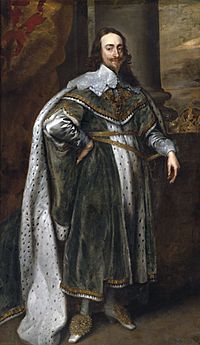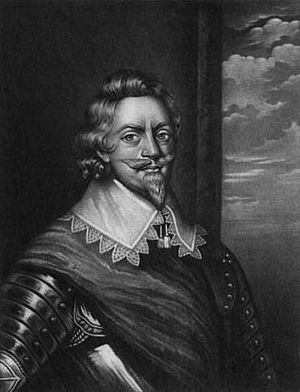Cornwall in the English Civil War facts for kids
Cornwall played a big part in the English Civil War. It was a strong area for the King's supporters, called Royalists, even though most of the southwest of England supported Parliament.
Key Events in Cornwall's Civil War
The English Civil War lasted for almost nine years. It started with the battle of Edgehill in October 1642 and ended with the battle of Worcester in September 1651. Here are the main things that happened in Cornwall during this time.
1642: Cornwall Stands with the King
In October 1642, Cornwall became secure for King Charles. About 10,000 local men, led by Royalist gentlemen, drove out the small group of Parliamentarian soldiers who were in Launceston.
Sir Ralph Hopton formed the Cornish-Royalist Army in 1642. Their first try to invade Devon failed, but they managed to control the Cornish side of Plymouth Sound. This was a setback for the Parliamentarian forces.
1643: Royalist Victories
The Battle of Braddock Down
On January 19, 1643, the Battle of Braddock Down happened near Boconnoc. Parliamentarian troops, led by Colonel Ruthin, tried to invade Cornwall. But Sir Ralph Hopton's Royalist forces defeated them. This victory made Cornwall safe for the King. The Royalists then continued their siege of Plymouth, surrounding the city to cut off supplies by land.
The Battle of Stratton

The Battle of Stratton took place on May 15, 1643. The Parliamentarian army, led by the Earl of Stamford, was pushed back by Hopton's men after a full day of fighting. About 300 Parliamentarian soldiers were killed, and 1,700 were captured. They had to retreat to Bideford.
These wins for Hopton and his five 'Old Cornish' regiments helped them launch campaigns into Devon and Somerset. They captured Taunton and Bridgwater. However, Sir Bevil Grenville was killed during the victory at the Battle of Lansdown in Somerset, and Hopton was badly wounded. Later, Hopton's Royalist troops captured Bristol and then Exeter.
On December 13, the Royalists started a heavy attack on Plymouth's northern defenses, but it didn't work well. Sir Richard Grenville, who had previously supported Parliament, asked his soldiers to join the King's side. Parliament then called him a traitor.
1644: The Siege and a Major Battle
Siege of Plymouth
Sir Richard Grenville arrived in Plymouth in March 1644 to keep up the blockade. But it became a stalemate because the people inside the city managed to get enough food to survive. Robert Devereux, the Earl of Essex, arrived with the Roundhead (Parliamentarian) army of 8,000 men. He forced Grenville to retreat back into Cornwall across the River Tamar.
The Battle of Lostwithiel
In June 1644, the Earl of Essex led an army of 9,500 soldiers into the Southwest. He ended Royalist sieges at Lyme and Plymouth without a fight. With these successes, Essex moved into Cornwall on July 26, thinking he would get local support against the Royalists.
However, on that very same day, King Charles arrived in Exeter. He planned to find and destroy Essex’s army. King Charles slowly moved west, gathering more soldiers. His army grew to 19,000 men by joining up with the Royalist armies of Prince Maurice and Richard Grenville. Because the King's army was so large, Essex found himself trapped on the peninsula, with the sea as his only way out.
Essex quickly moved his army to the small town of Lostwithiel, about nine kilometers north of the port at Fowey. By August 13, King Charles and his army reached Lostwithiel. Eight days later, the Royalists attacked. They easily took the high ground north and east of Lostwithiel from Essex’s forces.
Essex was in a very difficult spot. He tried to escape on August 31. First, he ordered his cavalry (soldiers on horseback) to cross the River Fowey and flee to Plymouth, which they did successfully. Then, Essex tried to retreat to Fowey with his infantry (soldiers on foot). But King Charles had been warned of Essex’s plan and immediately chased the Parliamentarians. The battle started at 7:00 AM and lasted for eleven hours as Essex tried to get away while King Charles kept pursuing him.
By 6:00 PM, the Royalists had surrounded the Parliamentarians at Castle Dore, about four kilometers north of Fowey. The Royalists stopped their attack for the day, and the Parliamentarians were beaten and exhausted. Without a chance of reaching Fowey with his infantry, Essex and his commanders secretly left during the night. They used a fishing boat to escape to Plymouth.
On September 2, Philip Skippon, the commander of the Parliamentarian infantry, surrendered. The Royalists took 6,000 Parliamentarians as prisoners. They were allowed to return to Southampton after giving up their weapons.
The Battle of Lostwithiel was a huge victory for King Charles. It was the biggest loss the Parliamentarians suffered in the First English Civil War. For King Charles, this win secured the Southwest for the rest of the war. For the Parliamentarians, this defeat led to arguments and changes. It helped lead to the creation of the New Model Army, a more professional fighting force.
1645: New Armies and Royalist Struggles
In 1645, Sir Thomas Fairfax became the commander of the New Model Army for Parliament. The Royalist army was also reorganized, with Prince Charles (the King's son) becoming their Commander-in-Chief.
The Royalists suffered a big loss at the Battle of Naseby in Northamptonshire. Parliamentarian forces gained more ground in the south and west of England. Prince Charles spent much of the autumn and winter in Cornwall, mainly in Launceston and Truro. Sir Richard Grenville was even put in Launceston Prison by the Prince for not obeying Lord Hopton. He had already argued with General George Goring.
1646: The End in Cornwall
In 1646, Prince Charles gave Lord Hopton command of the Royalist forces. William Wentworth, 2nd Earl of Strafford was to lead the cavalry, and Grenville the infantry. But Grenville refused and was imprisoned on St Michael's Mount.
Hopton moved from Stratton towards Exeter, reaching Torrington. But he was met by Fairfax's men and had to fall back to Stratton. The Parliamentarian Roundheads then entered Cornwall, reaching Launceston on February 25, 1646, and Bodmin on March 2. Hopton's army was falling apart, but he still refused to surrender. News that an Irish invasion was coming further hurt the Royalist cause in the area. Fairfax then offered Hopton terms for surrender. The surrender happened at Tresillian Bridge, near Truro, on March 15, 1646.
1648: A Small Rebellion
The Gear Rout
The Gear Rout was a small rebellion in Cornwall in 1648, after the main part of the Civil War had ended. On May 16, 1648, 70 Cornish Royalists were killed in Penzance. This led to a failed uprising by about 500 Cornish rebels. They fought against the Parliamentarian forces of Sir Hardress Waller near the Helford River.
Important Military Figures in Cornwall
Here are some of the key people who were involved in the fighting in Cornwall during the Civil War:
- Jacob Astley, 1st Baron Astley of Reading
- Arthur Capell, 1st Baron Capell of Hadham
- King Charles I of England
- Prince Charles, Duke of Cornwall
- William Coryton
- Robert Devereux, 3rd Earl of Essex (Parliamentarian leader)
- Thomas Fairfax (Parliamentarian leader)
- George Goring, Lord Goring
- Bevil Grenville
- Sir Richard Grenville, 1st Baronet
- Henry Grey, 1st Earl of Stamford (Parliamentarian leader)
- Ralph Hopton
- Robert Rich, 2nd Earl of Warwick (Parliamentarian leader)
- Patrick Ruthven, 1st Earl of Brentford
- John Robartes, 1st Earl of Radnor (Parliamentarian leader)
- William Scawen
- Philip Skippon
- Nicholas Slanning
- John Trevanion
Images for kids





